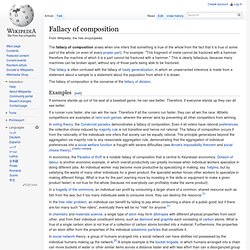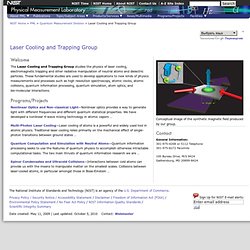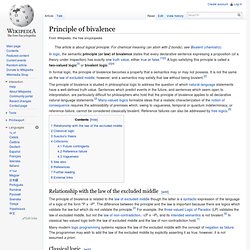

Fallacy of composition. The fallacy of composition arises when one infers that something is true of the whole from the fact that it is true of some part of the whole (or even of every proper part).

For example: "This fragment of metal cannot be fractured with a hammer, therefore the machine of which it is a part cannot be fractured with a hammer. " This is clearly fallacious, because many machines can be broken apart, without any of those parts being able to be fractured. This fallacy is often confused with the fallacy of hasty generalization, in which an unwarranted inference is made from a statement about a sample to a statement about the population from which it is drawn. The fallacy of composition is the converse of the fallacy of division.
Examples[edit] If someone stands up out of his seat at a baseball game, he can see better. If a runner runs faster, she can win the race. Tragedy of the commons. The tragedy of the commons concept is often cited in connection with sustainable development, meshing economic growth and environmental protection, as well as in the debate over global warming.

It has also been used in analyzing behavior in the fields of economics, evolutionary psychology, anthropology, game theory, politics, taxation, and sociology. However the concept, as originally developed, has also received criticism for not taking into account the many other factors operating to enforce or agree on regulation in this scenario. Lloyd's pamphlet[edit] In 1833, the English economist William Forster Lloyd published a pamphlet which included an example of herders sharing a common parcel of land on which they are each entitled to let their cows graze.
In English villages, shepherds had sometimes grazed their sheep in common areas, and sheep ate grass more severely than cows. Laser Cooling and Trapping Group Homepage. The Laser Cooling and Trapping Group studies the physics of laser cooling, electromagnetic trapping and other radiative manipulation of neutral atoms and dielectric particles.

These fundamental studies are used to develop applications to new kinds of physics measurements and processes such as high resolution spectroscopy, atomic clocks, atomic collisions, quantum information processing, quantum simulation, atom optics, and bio-molecular interactions. Nonlinear Optics and Non-classical Light—Nonlinear optics provides a way to generate light with different frequencies and different quantum statistical properties.
We have developed a nonlinear 4-wave mixing technology in atomic vapors … Multi-Photon Laser Cooling—Laser cooling of atoms is a powerful and widely used tool in atomic physics. Traditional laser cooling relies primarily on the mechanical effect of single-photon transitions between ground states … JQI Researchers Create 'Synthetic Magnetic Fields' for Neutral Atoms. Achieving an important new capability in ultracold atomic gases, researchers at the Joint Quantum Institute, a collaboration of the National Institute of Standards and Technology (NIST) and the University of Maryland, have created “synthetic” magnetic fields for ultracold gas atoms, in effect “tricking” neutral atoms into acting as if they are electrically charged particles subjected to a real magnetic field.

The demonstration, described in the latest issue of the journal Nature, not only paves the way for exploring the complex natural phenomena involving charged particles in magnetic fields, but may also contribute to an exotic new form of quantum computing. As researchers have become increasingly proficient at creating and manipulating gaseous collections of atoms near absolute zero, these ultracold gases have become ideal laboratories for studying the complex behavior of material systems.
. * Y.J. Lin, R.L. Compton, K. Interesting FlashG Blogs!! Principle of bivalence. In formal logic, the principle of bivalence becomes a property that a semantics may or may not possess.

It is not the same as the law of excluded middle, however, and a semantics may satisfy that law without being bivalent.[2] The principle of bivalence is studied in philosophical logic to address the question of which natural-language statements have a well-defined truth value. Sentences which predict events in the future, and sentences which seem open to interpretation, are particularly difficult for philosophers who hold that the principle of bivalence applies to all declarative natural-language statements.[2] Many-valued logics formalize ideas that a realistic characterization of the notion of consequence requires the admissibility of premises which, owing to vagueness, temporal or quantum indeterminacy, or reference-failure, cannot be considered classically bivalent.
Reference failures can also be addressed by free logics.[5]